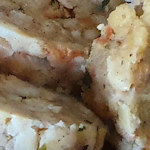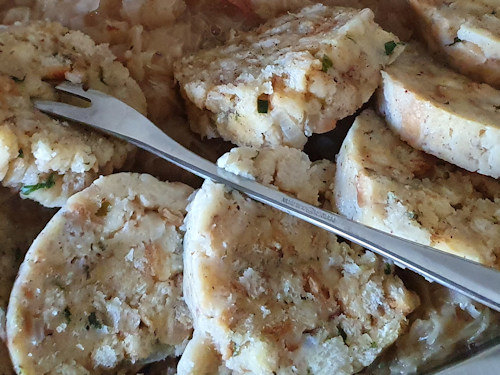
Many Viennese menus contain various dishes all ending in the word knödel, which sounds like something you might find in an IKEA catalogue. We have Marillenknödel, Semmelknödel, Leberknödel, Germknödel, and more.
So what is a knödel and what are all these different versions?
- Austrian dumplings that come in both sweet and savoury form
- See also:
Dumplings. Sort of.

(Serviettenknödel – notable for being served in slices, not as a rounded dumpling)
The German word Knödel translates as dumpling, a concept guaranteed to strike fear into anyone brought up in 1970s England. My mum would throw suet dumplings into beef casseroles, where they lurked like gelatinous icebergs ready to sink the unwary eater.
Anyway, the term covers a wide range of dumpling-type foods, all cooked in water. The wide variety on offer largely results from changing the ingredients used in the basic knödel dough.
The concept stems from the earthy side of traditional Austrian cooking, and the local cuisine manages to have two quite different knödel categories:
- Those you might eat as (or with) a starter or main course
- Sweeter versions that sit happily on the dessert menu
Starter & main course knödel
These knödel consist of robust varieties designed to see you through harsh winters in isolated log cabins. You eat them or, if necessary, use them as ammunition for your siege artillery.
Popular options include the knödel you might find in an otherwise unassuming consommé-type soup. For example:
Leberknödel

(Leberknödel in soup)
A smallish dumpling typically made of minced bread, onions, liver, and possibly other offal (such as kidneys).
Kaspressknödel

(Another common addition to the innocent soup – the Kaspressknödel)
Another dwarf dumpling, this time made from cheese and small cubes of bread, and then flattened. The Kaspressknödel comes from the west side of Austria, but you also find it in Vienna (sometimes as a standalone dish).
Griessnockerl

(Soup with Griessnockerl)
A semolina-based knödel to give a carbohydrate boost to your soup.
You may have spotted the word nockerl sliding in there to replace knödel. Viennese cuisine likes to throw a few linguistic complications into the path of innocent visitors.
Nockerl, for example, usually has two culinary meanings.
- Something that’s actually a knödel, but smaller and more oval. As in Griessnockerl. You might also find Leberknödel described as Lebernockerl
- A different kind of dough entirely, normally based on flour, eggs, and dairy products
Let us move on to common knödel used as main dishes or sides…
Semmelknödel & Serviettenknödel
A Semmel is a white bread roll, which suggests the Semmelknödel might be a bread-based dumpling. Correct! Small cubes of dry white bread make up the main ingredient.
One variation involves forming tubes of that dough, rather than balls, wrapping them in a cloth napkin (Serviette), and then boiling in water. You serve the resulting Serviettenknödel in slices.
This knödel traditionally accompanies one of the more classic Austrian dishes: Schweinsbraten (a form of roast pork). The bread dumplings soak up the gravy rather nicely.
This (side) dish also offers the possibility of forming some of those gorgeous long German words. A Buttermilchserviettenknödel, for example, adds buttermilk to the recipe.
Fleischknödel
Fleisch means meat in German, so a Fleischknödel is pretty much as it sounds: a thick outer layer of (potato) dough and a centre filled with some form of processed meat…perhaps mince, smoked pork, or similar.
A traditional variation is the Grammelknödel. I have no idea how to translate Grammel, which seems to be some derivative of fried pork skin that’s eaten in small pieces.
I tried Grammelknödel once back in the mid-1990s. Just once.
The dessert Knödel

(A Marillenknödel)
Turning to the sweeter side of the menu, the dessert knödel are true Hall of Fame representatives of Austrian and Viennese cuisine. Popular varieties include:
Topfenknödel
The curd cheese or quark dumpling forms a dessert in its own right, but also provides the basic dough typically used as the outer layer in fruit dumplings like the Marillenknödel.
Topfenknödel might consist of a quark, egg and butter dough, cooked in water, then rolled in fried breadcrumbs and dusted with icing sugar.
Marillenknödel & Zwetschkenknödel
Fruit dumplings have delighted Austrian palates for many a year.
Essentially, a piece of fruit sits in the centre of a sweet dumpling dough, with the final product coated in sugar and fried breadcrumbs as above.
The nation’s favourite and a common item on restaurant menus is the Marillenknödel (apricot dumplings), followed someway behind by the Zwetschkenknödel (plum dumplings).
Numerous other fillings exist, such as cherries or even balls of chocolate nougat.
Germknödel
Finally, on the dessert side of things, say hello to the monster pudding otherwise known as the Germknödel. A giant half-sphere of yeast dough, filled with powidl (a kind of plum jam), and sprinkled with poppy seed and icing sugar.
Melted butter normally accompanies the Germknödel, but vanilla sauce is a popular option too.
So, there you have it. The knödel in all its common forms.